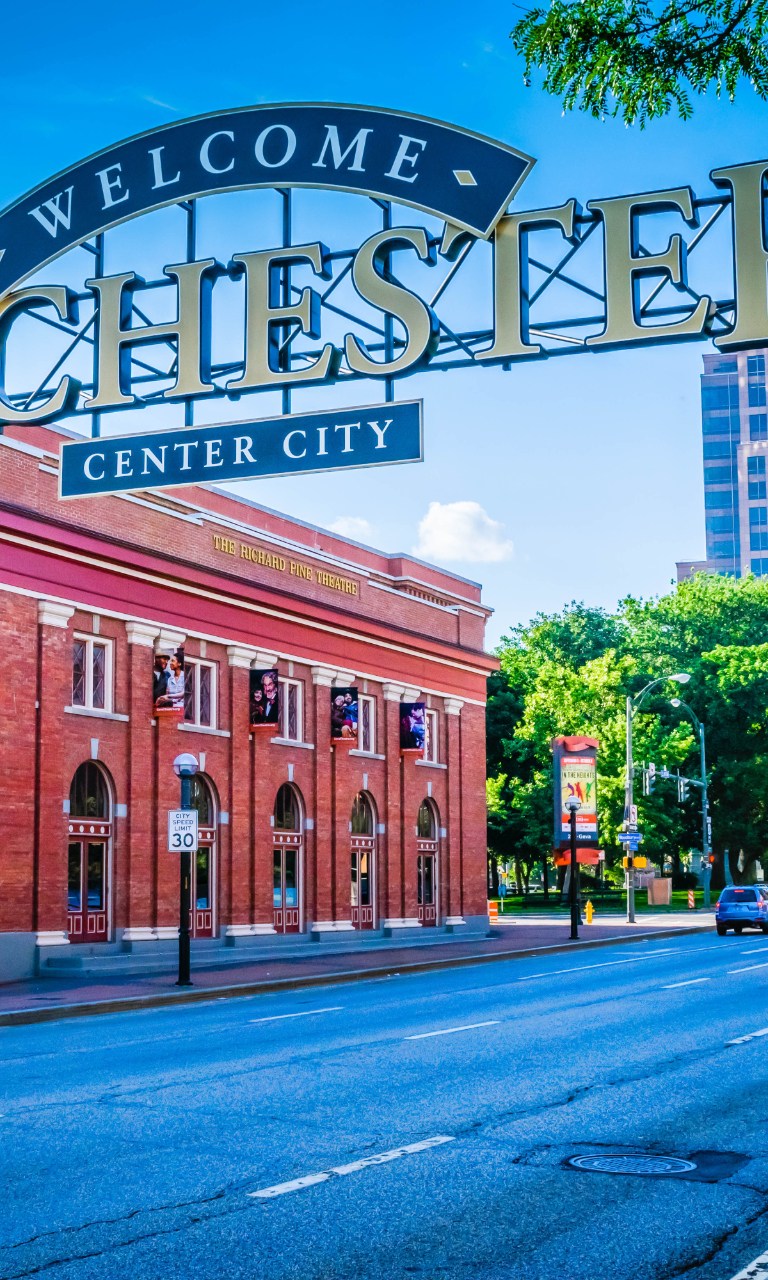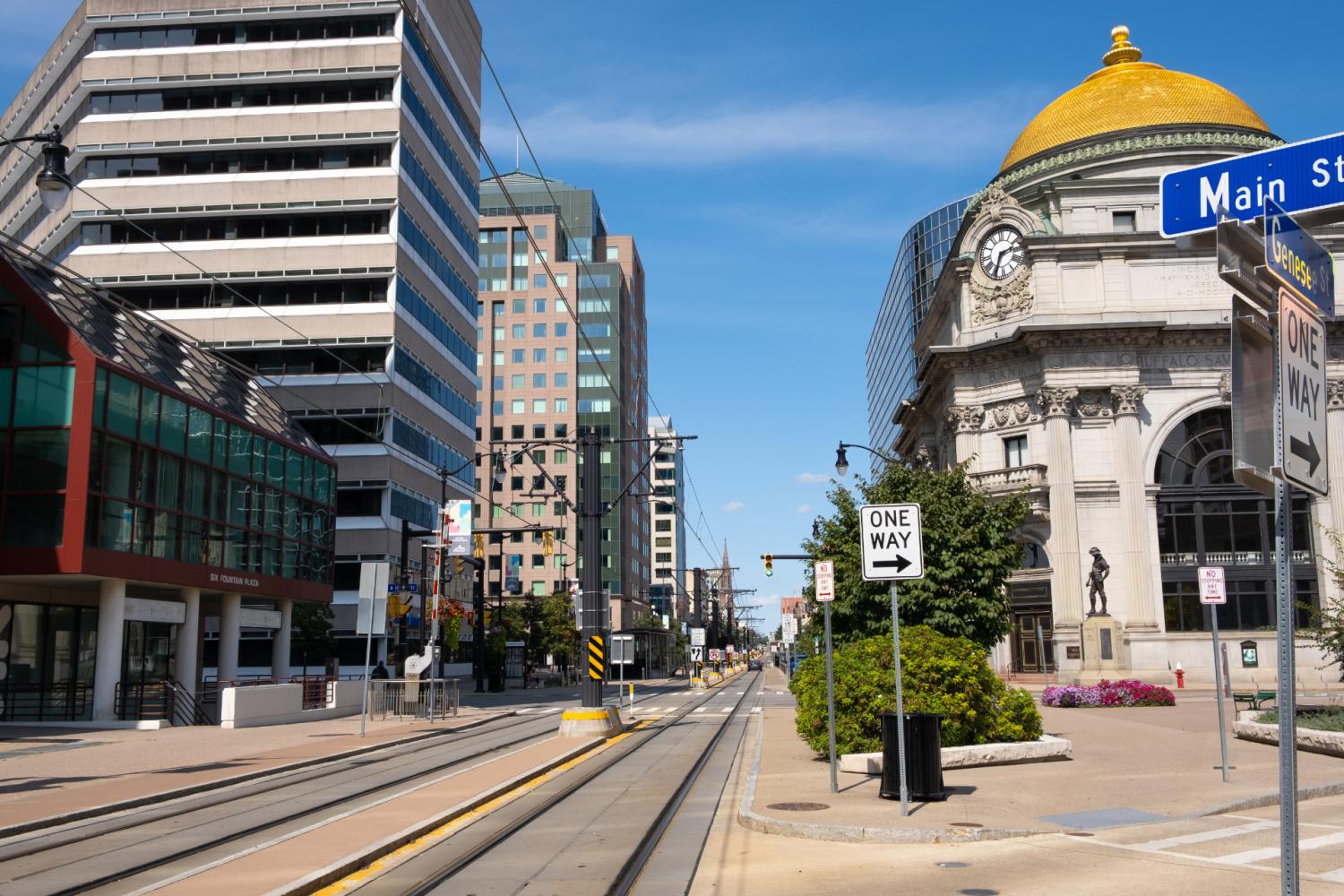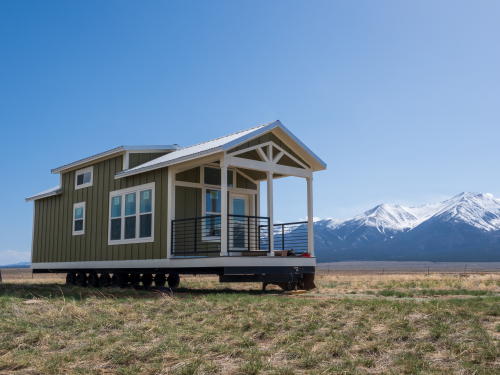The Open4 program discussed in this report illustrates many of the points outlined in From relief to recovery: Using federal funds to spur a small business rebound which is part of the American Rescue Plan: Strategies for Local Leaders series.
In February 2020—barely a month before the COVID-19 pandemic shut down New York—Tommy Summage, a Black small business owner in Buffalo, was awarded Entrepreneur of the Year by a local nonprofit. After more than a decade of overcoming barriers, Summage finally received the business advice and local nonprofit loans he needed to launch A1 Express, which provides non-emergency transportation to medical appointments for Medicaid patients,1 filling a recognized gap in his community. Summage, benefitting from a family mentor, was more fortunate than many minority and women entrepreneurs who—facing multiple hurdles to realizing their dreams—are ultimately unable to obtain fundamental assistance.
Like many “legacy” regions, Western New York (comprising the Buffalo and Rochester metro areas) has been in steep economic decline for decades. Part of a cohort that includes Cleveland, Detroit, Pittsburgh, St. Louis, and others, these legacy cities contend with consistently high poverty rates, low labor force participation rates, and a high percentage of low-income minority entrepreneurs unable to access traditional financing systems relative to white business entrepreneurs. To a newcomer to the region, Western New York’s (WNY) entrepreneurial ecosystem appears particularly strapped for resources, posing barriers for minority- and women-owned business enterprises (MWBEs) to start and/or scale businesses. In a 2018 assessment, the Ralph C. Wilson, Jr. Foundation, which was new to the region, observed a fragmented collection of nonprofits (which grew up somewhat autonomously based on past government funding streams and targeted investments) not optimizing their individual contributions or potential for collaboration. Business support organizations typically had limited staff capacity, and there were clear gaps in critical services without adequate funding to fill them.
Alongside structural barriers and a history of underinvestment in the nonprofits comprising the WNY entrepreneurial ecosystem,2 there appeared to be low levels of coordination and information-sharing among the organizations. Still, the players were doing the best they could with limited resources. On the ground, these groups had begun working together to build awareness among MWBEs of their resources and pool intake for concessionary loans among multiple community development financial institutions (CDFIs) and microlenders. But there was no clear path for these efforts’ sustainability or a plan to scale.
The ecosystem’s fragile baseline pointed to the need for a dramatic and strategic shift using an injection of funds to accelerate change. This case study documents Open4—a unique philanthropic effort to catalyze systemic changes and help minority and women entrepreneurs realize their ambitions. (Note: The author of this report worked for the Ralph C. Wilson, Jr. Foundation, which led the launch of Open4 along with the five other founding partners.) In this account, a regional foundation made plans to launch a fund to support loans as well as business service and technical assistance advice. As the pandemic hit, multiple partners formed into a single foundation—responding to acute need and the rapidly changing public funding landscape. Ultimately launched in the throes of the pandemic economic crisis, Open4 represents an intense collaborative spirit and focus to influence and shape the ecosystem via grantmaking, pivoting in response to the pandemic to prioritize business services and technical support over loans.
While one new fund alone cannot overcome deep-seated racial barriers to wealth-building, Open4 provides a compelling model to address multiple complex obstacles that have long prevented MWBEs from accessing dollars and other essential supports for startup and scaling. Accelerated by the pandemic, the fund addresses MWBE demand for greater opportunity and support while also positioning the network to act in concert. Open4’s formation reveals both the challenges and opportunities of thinking big, as well as the role of philanthropy in jump-starting a market-based solution. While still in its formative stage, Open4’s development process and structure offer lessons for other legacy cities and regions experiencing similar systemic challenges.

The multiple challenges at systemic, organizational, and business levels
At the macro level, small businesses generally provide local amenities and experiences that enrich our lives and anchor our communities. They are also a critical source of income and wealth generation for their owners. A subset of small businesses—young businesses (those that are zero to five years old)—are the primary drivers of the nation’s net job creation and productivity growth. Therefore, success in an Open4-type effort—which is instrumental in supporting and scaling MWBE small business growth in WNY—is likely to profoundly influence the region’s competitive advantage for years to come.
Western New York’s distinct systemic challenges
Minority small business entrepreneurs in legacy cities across the East Coast and Midwest face many obstacles to starting their businesses. These challenges are deeply rooted in historical structural racism perpetuated in Buffalo and other similar Northern cities through redlining, segregated settlement patterns, and other invidious policies and practices. These practices, in turn, hinder minority small business growth and other wealth-building efforts. Racist conditions reduce minority businesses’ access to conventional bank loans, prevent wealth formation, and hinder networks of family and friends or other natural supports that all business entrepreneurs depend upon, and which would naturally help Black and brown business entrepreneurs capitalize their businesses and obtain business advice. While Black Americans start businesses at higher rates than white Americans, due to structural barriers, Black-owned small businesses are more likely to close within four years than white-owned small businesses. These higher failure rates result in a greater likelihood of downward mobility for Black entrepreneurs compared to white entrepreneurs.3
Across the country, small businesses create more than two-thirds of all new jobs in the private sector. In places where substantially lower percentages of minorities and women obtain small business loans (particularly those with higher concentrations of minority populations, such as Buffalo and Rochester), small business growth is constrained, thus limiting economic growth and restricting job growth and market expansion. Traditional banks turn down hundreds of loan requests annually, usually due to lack of collateral and other credit indicators or basic business operations and management knowledge, such as insufficiently developed business plans. The latter are often a function of basic financial literacy, meaning the technical skills necessary to start and run a business: budgeting, accounting, managing cash flow, tax and financing strategy, etc. These are skills that can be readily learned through targeted programming. The interconnectedness of structural racism’s financial impacts (lower homeownership rates, lower generational wealth, etc.) and the many cascading effects (including declined loan applications, of which a basic financial literacy gap is only one important factor) are well-documented barriers to minority small business formation.4
Not surprisingly, with these underlying challenges, the WNY small business ecosystem is underperforming relative to comparable cities. A study revealed that WNY, particularly Buffalo, lags significantly behind other comparable cities (e.g., Pittsburgh, Detroit) with five to six times lower rates of CDFI lending per capita.5 An anemic pipeline is one explanation: Local entrepreneurs from lower-income communities don’t know where to turn, while CDFIs are often not in a position to increase the number and range of loans they make to meet the need due to low capacity, insufficient flexible capital, or “credit box” constraints. Cities vary in the number of CDFIs and business support organizations (BSOs) they have and their capacities. But where these nonprofits exist, they are essential to feeding business startups in minority and low-income communities.
The complex supply and demand side barriers for small business entrepreneurs
A philanthropy-led, pre-COVID assessment of the WNY small business entrepreneurial landscape surfaced a myriad of barriers that consistently prevent women, Black, brown, and other minority (e.g., immigrant) entrepreneurs from starting and scaling businesses.6 With the end goal of developing a fund that would optimize the capital ecosystem for underserved entrepreneurs, the assessment uncovered a range of specific supply and demand challenges—although the number-one need that emerged on both sides of the ledger was “business readiness.”
On the supply side, the challenges fall into two buckets:
- The uneven condition of individual nonprofit organizations (e.g., CDFIs, BSOs), resulting in insufficiently meeting current small business needs and inability to scale to meet future needs
- Individual nonprofits generally lack capacity (e.g., insufficient staffing and staff training) to meet businesses’ needs for pre-loan supports and services.
- Sustainability of individual organizations is a critical problem; one analysis found that one BSO “would take years” for its business model to break even.
- Too few—or not the right types of—organizations exist to provide business advice, relative to need.
- A fragmented and unfocused ecosystem
- Fragmented, low-capacity individual organizations undercut the ecosystem’s strength.
- Diffuse types of businesses served limit the effectiveness and expertise of small business growth strategies.
- Lack of a BSO network stymies referrals and limits handoffs between organizations, undermining entrepreneurs’ ability to obtain financial resources and other supports.
- Lack of a central coordinating entity—or incentives to coordinate—leads to individual organizations being disconnected from each other, thus obscuring optimal referral pathways.
- Competition for resources and lack of communication between Buffalo, Rochester, and their regions subvert potential to build and leverage mutual benefits from joint infrastructure and investments in both places.
On the demand side, businesses expressed the need for more flexible lending criteria and higher levels of technical assistance, specifically:
- The need for more flexible lending from banks and CDFIs
- Design and capitalize loan products with less rigid lending guidelines (e.g., credit scores, collateral requirements) to ease frustration with high levels of bank loan declinations and ease access to available capital.
- Create MWBE-targeted funds for debt and equity, with knowledgeable and well-connected approval committees and a deep understanding of borrower communities.
- Increase levels of technical assistance or wraparound services
- Increase the quality and reach of classes and the adequacy of cohort and mentoring programs.
- Focus on provision of business credit resources and longer-term credit-building and financial readiness support.
- Address inconsistencies in connectivity to and feedback from capital providers on loan applications and fill gaps in pre-loan borrower development and support.
- Enhance post-loan support for CDFI borrowers.
COVID-19 only compounded these challenges, particularly for Main Street businesses in legacy cities with weak or fragile minority small business supports. Nationally, the pandemic’s business closure rates were higher among small businesses in majority-minority neighborhoods (36%) compared to businesses in majority-white neighborhoods (22%), in part because businesses in COVID-disrupted industries (e.g., food services, retail, accommodations) were disproportionately concentrated in those neighborhoods.7 In New York, a survey revealed that 30.6% of small businesses felt COVID-19 had a “large negative effect” on them—5.4% above the national average.8 At the same time, anecdotally, it has been reported that some Black business entrepreneurs are seeing the pandemic as an opportunity, thus triggering greater demand for supports and services.9
 Photo by Shamir Hunley on Unsplash
Photo by Shamir Hunley on Unsplash
Creating Open4 to aid underserved small businesses
Open4 (as in “open for business”) is a collaborative made up of regional private foundations, financial institutions, and corporate entities that have made commitments totaling up to $10 million over three to five years to support nonprofit partners that, in turn, serve MWBEs. While it aims to fill multiple gaps and leverage existing strengths of the Buffalo/Rochester ecosystem, Open4 also introduces a new element: collaborative, sustained, data-driven dialogue within and across the two regions about what is happening on the ground and what is missing. Built on the prior assessment and preliminary thinking of one foundation, the new structure has catalyzed problem-solving and introduced “net new” resources to fund the identified gaps and opportunities. In the context of the pandemic, Open4 is installing new mechanisms to absorb expansive government inflows of funds.
Key decisions in operationalizing Open4
Open4 is distinct in generating a holistic and aspirational funding program that meets the ecosystem where it is. A few key decisions also built trust and cemented the role and value of existing system players. Assembling multiple pieces simultaneously, Open4 funders coalesced around a startup decision to primarily work with and augment existing organizations in the ecosystem rather than introduce new nonprofits. In conjunction with this decision, the group brought in two national partners on a temporary assignment to foster closer working partnerships among the existing players and advise on outreach and platform development across the two regions. These decisions deepened Open4’s expertise and built trust with the existing CDFIs and BSOs, who understood that scarce resources would flow to them before outsiders. The national advisors’ roles also include providing feedback to help perfect the program, the funding sequencing, and backfilling capacity. Finally, the Open4 program built a local team to coordinate the group and locally drive the process.
The founding funders also made a choice to sequence the grantmaking—prioritizing grant funding to the few CDFIs first to help with capacity-building.10 This decision bolstered Open4’s strategy to address the common “Catch-22” phenomenon in legacy cities, in which existing intermediaries such as CDFIs often require capacity-building before they can even leverage the new resources needed to respond to business needs. This decision to build CDFI capacity augments the WNY ecosystem’s limited ability to absorb massive federal relief dollars coming down the pike (such as the Paycheck Protection Program, the Economic Injury Disaster Loan program, and the Coronavirus State and Local Fiscal Recovery Fund), which otherwise may prevent it from spawning critical small business growth. The next tranche of funding is poised to go to BSOs to double down on providing business services. Already, successful BSO funding proposals reflect the collaborative spirit that Open4 is incentivizing.
Finally, Open4 is galvanizing Buffalo and Rochester by attracting funders from and providing grants to entities in both regions to solidify economic gains for all small businesses that can access the organizations’ expertise.

Open4’s design principles
Open4 is predicated on five key principles that make it replicable in other legacy cities facing similar challenges.11
- Make equity and sustainability the guiding goals. From the start, Open4’s design elevates equity and sustainability as the leading principles. In response to long-term market gaps and urgent needs, Open4 advances equity by improving opportunities for minorities and women to start businesses and build wealth and creates a sustainable and coordinated system of nonprofit support organizations in the WNY region. Long-term sustainability also positions Open4 to leverage state and federal resources and corporate/philanthropic commitments—establishing the groundwork and vision for systems transformation. The decision to fortify and bolster existing organizations as an operational tenet further supports the sustainability principle.
- Establish collaboration as a critical value for success. In April 2020, a group of funders in Buffalo came together to address COVID-19’s devastating impact on minority communities. Building on the pre-pandemic needs assessment, this core group of philanthropic and corporate representatives met regularly, as the pandemic represented a critical inflection point and an unparalleled opportunity to address long-standing challenges and racial disparities in minority business formation. After extensive discussions, the group funded Open4, designed to support CDFIs, BSOs, and other nonprofit partners to offer enhanced businesses financial support, programs, and services; build their capacity to assist more businesses; and provide joint marketing and promotion of their offerings.
The collaborative spirit is a benefit to Open4 funders, but most importantly, to its grantees and the grantees’ clients. Open4’s six founding partners12 (two banks, three foundations, and one corporation), together, established operating guidelines and formed an Advisory Council to oversee and advance the fund’s vision, strategies, and grantmaking. Additionally, Open4 intentionally spans two metro areas (Buffalo and Rochester) whose business and economic ecosystems traditionally have been remarkably distinct. The promise of the fund’s collaborative spirit and bi-regional construct are based on the premise that these metro areas are more powerful together and will be a springboard for harnessing resources to address wealth-building, small business growth, and, eventually, place-based economic growth in targeted neighborhoods. Finally, the philanthropic partners realize the benefits of leveraging and cross-fertilizing grantmaking across the regions, while the banks and credit unions involved in Open4 can often supply helpful background on conventional loan declinations that assist the CDFIs in serving their clients. - Create a flexible private fund to leverage public dollars. Creating a program that can be responsive to evolving needs and absorb public funds is essential. Open4’s structure evolved through input from all the partners as well as real-time information about federal relief funds. By the time the program launched and made its first set of grants to the CDFIs in fall 2020, the group had adjusted so that philanthropic dollars were strategically positioned to complement and leverage federal funds. Experience demonstrated the need to be responsive and flexible, even in the setup. For instance, Open4’s original components—loan funds, loan loss reserve, pre- and post-loan technical assistance, building operational and staff capacity, and ramping up marketing to increase awareness of services—were intended to bolster the system and set up individual CDFI and BSO organizations (with differing challenges and levels of sophistication) for success.
But local and state loan funds had emerged that influenced Open4’s structure and focus. These included the New York Forward Loan Fund and the Erie County Back to Business Grant Program,13 which provided direct supports to businesses, in addition to Paycheck Protection Program loans. Instead of supplying loan funds and loan loss reserve (as originally contemplated), Open4 doubled down on funding to shore up the system for the longer term, with technical assistance and capacity-building for lenders and BSOs (investments complementary to the federally available direct business loans and grants) and the assembly of a local project management team. - Prioritize technical assistance to unlock minority small business growth. Multiple barriers dampen enthusiasm and the ability for minority entrepreneurs to access and engage with the nonprofit ecosystem. Open4 prioritized increased technical assistance (TA) and pre-loan support as a key game-changing tactic for startup business owners, paired with the post-loan support discussed above. Meeting TA and financial literacy needs is a predicate to businesses obtaining loans and meeting challenges more confidently.13 Open4 focuses on augmenting local organizational capacity to carry out the TA and business services training, primarily because many of the nonprofits serving the WNY ecosystem are still in their infancy, having sprung up organically to meet community demand and fill profound gaps left by the traditional finance and banking system. Because of their relative youth, it is not surprising these nonprofits need extra organizational support and trainings themselves.
Additionally, in a few instances, organizations’ origins may explain the disconnect between training and borrower needs. For instance, where staff are providing social services as their core mission to low-income populations, they may see demand for business startup advice (to address financial needs of clients that underlie other challenges) and are motivated to venture into business services and TA. Not core to its mission, an organization may operate their business services side on shoestring budgets or remain undercapitalized, particularly at the scale needed to serve growing or unmet market demand. - Establish an entity to coordinate and build a network. A missing but critical feature in ecosystems like WNY’s is a long-term coordinating entity or network manager. The organic nature of organizations’ growth trajectories puts undue pressure on the system—meaning the response to growing needs is often ad hoc and scaling occurs reactively rather than proactively. This network manager’s role is proactive and draws on systemwide information and problem-solving to guide growth. So too has coordination among individual organizations been minimal; for instance, client handoffs occur (e.g., from a BSO providing TA, to a CDFI offering loan assistance), but small business entrepreneurs are inadequately prepared to apply for a loan. Again, network managers can help ensure more informed handoffs and connectivity at all levels.COVID-19 exposed and exacerbated the flaws and deep weaknesses in these systems, making development of a holistic response even more compelling and timely. So, this coordinating function should be charged with several critical functions to build the ecosystem while also bolstering individual organizations:
- Conduct marketing and awareness campaigns to build a pipeline of new and established businesses for all ecosystem components, including relational outreach to communities who have historically been disconnected or lacked trust in the system.
- Understand market strengths and weaknesses to function as a connector and inform the direction and focus of individual organizations.
- Pilot and scale innovation to introduce new practices.
- Engage with new entrants to the market or respond to catastrophic events (like a pandemic).
- Monitor so that new funds don’t flood already overworked or under-capacity organizations.
- Work with local institutions to introduce new, locally sourced procurement practices targeting minority small businesses.

Open4’s next steps
While still in its infancy, Open4 is poised for growth and impact. The uncharted waters of the COVID-19 recession—including the shifting public funding landscape—are influencing philanthropic decisions on programmatic structure and type of investments to maximize public funds. Now, public programs offer the best opportunity in decades to leverage a fund like Open4 at a ratio as high as 10:1. To maintain momentum, Open4 needs to take the following critical steps:
- Leverage and deploy additional philanthropic dollars. With a critical mass of funds and a clear mission, Open4 is ripe to attract additional philanthropic dollars. Expansion of the fund ensures it continues to build capacity among existing nonprofit organizations to augment direct services to aspiring minority entrepreneurs. Explicit milestones are being set around the grants and creation of a long-term platform over the next five years. Beyond its current investments, Open4 should move in the near term toward making the next tranche of grants to BSOs, so they can provide critical pre-loan technical assistance and financial literacy while also monitoring current grants to CDFIs and identifying other important infrastructure-building grants.
- Create a consolidated business resource platform. Another concrete next step is to create a permanent business resource center to directly serve small business entrepreneurs and advance Open4’s equity and sustainability goals. This platform or center will expand targeted outreach to communities of color; improve awareness of ecosystem services; provide a one-stop entry point for small businesses; and market and disseminate information about the availability of technical assistance, loans, and other services. The platform would define a pipeline of supports for small businesses through all stages of growth, which are broadly: pre-loan readiness, loan application, and post-loan support. These supportive “wraparounds” are of equal importance to the loan funds, in business growth survival, and represent a unique value-add by philanthropy that the public sector and market do not normally provide.
Building on smaller, less developed portals in both metro areas, the platform is meant to democratize access to resources and open up the system, such that entrepreneurs are able to enter the ecosystem through one portal and benefit from multiple services—leading to amplified equity and inclusion in business creation. The platform also creates the opportunity for BSOs to embrace a customer relationship management model that can follow individual businesses across the system, creating valuable efficiencies and providing longitudinal data collection. The platform could also eventually be leveraged to provide insights and enable further coordination. To date, generating the platform has encountered some challenges, due to the need to consolidate and upgrade pieces of existing platforms and figure out where it will ultimately be housed. - Pursue American Rescue Plan (ARP) dollars, prioritizing SSBCI. Open4 is positioned to influence the use and deployment of federal rescue funds in the WNY ecosystem. States shape deployment of new State Small Business Credit Initiative (SSBCI) funds with the opportunity to funnel flexible capital to support CDFIs, support new intermediaries (like Open4), and increase private sector leverage.15 Open4 champions (e.g., philanthropy and local nonprofit leaders) can play an important role in advocating for innovative uses of federal funds such as: pooled loan funds; pre-loan technical assistance models; matching capital products with technical assistance; and devising place-based investments concentrated in one geographic footprint. Open4 can also play a significant role in mitigating the challenges of a nascent system (like those in WNY) in deploying large funding awards, in order to prevent awards ending up for purposes that are less or not at all equity-focused and to ensure funds are distributed using processes designed to address systemic barriers to access.
A priority step, then, is for Open4 to influence ARP reauthorization and expansion of New York’s SSBCI—for which an additional $10.5 billion has been approved nationally—and leverage these federal funds at the highest level (a possible 10:1 match). To realize the SSBCI’s potential, New York should value Open4 as an emerging intermediary partner in WNY that is willing to advise on regional needs and be flexible and innovative. Open4 stands as a ready vehicle for funneling SSBCI funds to WNY for transformative impact. - Take steps toward standing up a permanent intermediary to build the ecosystem and monitor individual organizational capacity. This could take the form of a formal new intermediary entity or an initiative housed with a high-capacity existing entity, such as a community foundation or a national nonprofit with local offices. As an intermediary, Open4 would monitor and ensure the increasing operational capacity of nonprofits serving small businesses. It would also coordinate with the demand side, such as through a newly conceived local procurement program aimed at connecting large institutional (e.g., hospitals, universities) purchasing needs to minority small businesses as suppliers,16 amplifying connections with these minority small businesses. With pandemic federal funds and their power as a springboard for larger economic and business growth, equity-driven, collaborative partnerships with concrete “leave-behinds” are essential.
Open4 is by design customized to WNY, although it addresses challenges common to legacy cities. The ultimate test of success will be quantifiable measures (e.g., increased numbers of new businesses; increased numbers served by nonprofits; business growth measured by revenues or number of employees). Future tangible benefits will need to include quality jobs and neighborhood-building arising from new businesses in commercial corridors.

Today, Tommy Summage and A1 Express are doing well, maintaining business operations and providing much needed services through the pandemic. A1 Express benefited from an emergency loan and a grant award through government pandemic-related programs as well as from critical technical assistance provided by two of the CDFIs supported through the Open4 program. These have allowed Summage to focus on continuing to grow his business and retain employees, despite the current environment.14
The stakes have never been higher—nor the opportunities greater—to break down historical barriers for minority entrepreneurs in legacy cities and install mechanisms for future wealth-building. While systemic fixes take a long time to take hold, it is hoped that Open4’s holistic approach creates short-term solutions and paves the way for critical long-term systems change.
-
Acknowledgements and disclosures
The author would like to thank Adina Astor for her helpful review of and input to this report, as well as M&T Bank staff for their thoughtful input and the Ralph C. Wilson, Jr. Foundation for its support. Any errors that remain are solely the responsibility of the author.
-
Footnotes
- Lauren Kirchmyer. Faith and commitment earn Tommy Summage WEDI’s Entrepreneur of the Year award (upstartny.org). February 21, 2020.
- A small business entrepreneurial ecosystem commonly consists of a network of nonprofit organizations, such as CDFIs and BSOs. Among other services, CDFIs provide essential loan capital and credit counseling to small businesses that cannot access loans from traditional sources, such as banks. BSOs offer pre-loan business counseling and the technical skills related to basic financial literacy.
- Joseph Parilla and Sifan Liu. “From relief to recovery: using federal funds to spur a small business rebound.” July 7, 2021. https://www.brookings.edu/essay/from-relief-to-recovery-stage-2-recovery/.
- Richard Rothstein. The color of law: a forgotten history of how our government segregated America. (New York: Liveright, 2017.)
- Presentation by RCWJRF staff and Next Street, Western NY Business Ecosystem: Business Support and Funder Convening,” December 9, 2019.
- The examination included: mapping available capital and technical assistance resources; analyzing capital supply (i.e., the size and trends within debt and equity markets with specific focus on capital flows to small and midsized enterprises [SMEs)]); assessing sector and industry SME composition as well as areas of growth and momentum, specifically those that promote inclusive growth; and scanning national models for financial literacy and credit building/repair programs and small business ecosystem best practices.
- Parilla and Liu. From relief to recovery: Using federal funds to spur a small business rebound | Stage 1: Relief (brookings-edu-2023.go-vip.net). July 7, 2021.
- Small Business Pulse Survey Data (census.gov).
- Quoctrung Bui. Small Businesses Have Surged in Black Communities. Was It the Stimulus? – The New York Times (nytimes.com). May 24, 2021.
- The three CDFIs that were initially funded, together, span the WNY region: Westminster Economic Development Initiative (WEDI), based in Buffalo; PathStone Enterprise Center Inc., based in Rochester; and Pursuit Community Finance, a multi-state entity with a local WNY office.
- Open4 is illustrative of types of response strategies outlined in a recent Brookings Metro report on use of federal funds for small business recovery. Parilla and Liu. From relief to recovery: Using federal funds to spur a small business rebound (brookings-edu-2023.go-vip.net).
- As of this writing, the six founding partners are: M&T Bank, KeyBank, Ralph C. Wilson, Jr. Foundation, John R. Oishei Foundation, Community Foundation for Greater Buffalo (CFGB), and Pegula Sports and Entertainment. M&T Bank and the Ralph C. Wilson, Jr. Foundation co-chair the Advisory Council. Along with the Wilson Foundation, M&T Bank played a key leadership role in launching Open4, and the fund is located at the CFGB. Two additional foundations, both based in Rochester, are considering joining as founders.
- Presentation by RCWJRF staff and Next Street, Western NY Business Ecosystem: Business Support and Funder Convening,” December 9, 2019
- Email from Yanush Sanmugaraja, Senior Director, Economic Development, Westminster Economic Development Initiative (WEDI). August 31, 2021.




